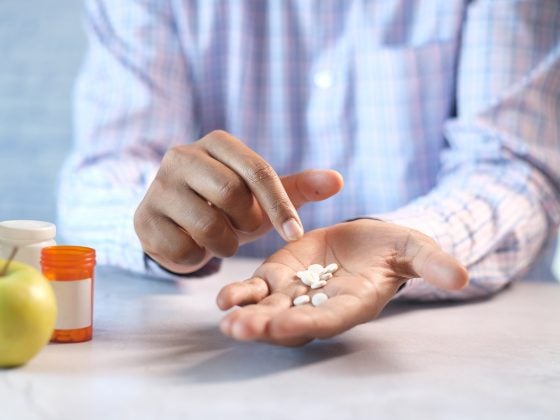It’s not an easy conversation to have, but three in five American men suffer from erectile dysfunction (ED). In fact, ED is the most common medical condition for men.
Yet, the vast majority of adult males who do not recognize ED could be an indication of a more serious health problem. A growing body of evidence has linked erectile dysfunction with a host of chronic illnesses including heart disease, high cholesterol, high blood pressure, strokes, and cardiovascular death.
Recognizing the symptoms and understanding the cause of ED can help men find effective solutions sooner rather than later. It’s often the case that a change in lifestyle choices presents a quick and easy fix.
What is Erectile Dysfunction?
Erectile dysfunction is typically described as the “persistent inability to achieve or maintain penile erection sufficient for satisfactory sexual performance.”
However, there are other symptoms of ED that male adults should watch out for. These include loss of sexual appetite, issues with ejaculation, and pain during sex.
Biologically, the cause of ED typically starts with issues in either the vascular system, the nervous system, or the endocrine system. For an erection to occur, the penis needs to receive a sufficient amount of blood flow and hormones that stimulate nerve cells that cause swelling.
When there is a malfunction in one of the body’s systems that prevents blood flow from finding its way to the penis, erectile dysfunction occurs. But there are usually underlying factors.
Psychological or emotional issues contribute to impotence including high levels of stress, anxiety, depression, low self-esteem, guilt, embarrassment, shame, or feelings of insecurity that you cannot satisfy a woman.
The condition can be exacerbated by smoking, heavy drinking, illicit drugs, being overweight, or a lack of physical activity. More serious conditions include disease and chronic illness that affect the flow of energy around the body.
Diseases Associated with Erectile Dysfunction
The issues mentioned above can also be responsible for the majority of other chronic illnesses and diseases. Research shows that almost every psycho-biological system in the body is negatively affected by chronic stress.
Erectile dysfunction has been linked with an extensive list of illnesses and diseases including:
- Type 2 diabetes
- Heart and blood vessel disease
- Cardiovascular disease
- High cholesterol
- High blood pressure
- Atherosclerosis
- Chronic kidney disease
- Obesity / overweight
- Multiple sclerosis
- Metabolic syndrome
- Peyronie’s disease
- Prostrate cancer
- Bladder cancer
- Parkinson’s disease
- Low testosterone
Treatment Options for ED
Although there are existing medical treatments men can use to tackle erectile dysfunction, most options have side effects.
Prescription medications like Viagra are most commonly prescribed, and arguably the preferred method of counteracting impotence. These are used on a ‘per sexual encounter’ and considered a short-term ED solution. These prescription medications are not a permanent solution for treating chronic impotence.
In addition, over-the-counter male enhancement pills are not FDA-regulated and come with multiple side effects ranging from pain in your chest, jaw, and shoulders to sudden hearing loss or blurred vision.
A lot of men choose to go down the route of corrective therapies. For men that experience erectile dysfunction due to low testosterone levels, the most likely option is testosterone replacement.
Testosterone replacement is not recommended for everybody. Medical professionals also reveal that replacement therapy is not a single solution and requires additional treatments which are personalized for each individual.
Penile injections or penile implants are also an option but typically involve nasty side effects including minor pain or bleeding, prolonged erections, and formation of scar tissue.
New Treatment Options for Erectile Dysfunction
In recent years, shockwave therapy has been found to be an effective treatment that improves the body’s various systems. The devices emit low-energy acoustic wave pulsations that trigger the body’s natural healing response.
Low-intensity shockwave therapy was initially used for treating wounds, bone fractures, and inflamed tendons after it was discovered the body’s ability to heal itself responded faster when exposed to acoustic vibrations.
Studies show that low-intensity wave pulsations stimulate blood flow – suggesting that shockwave therapy could be a better alternative for ED than the existing solutions mentioned above.
Shockwave therapy is a non-invasive treatment that involves massaging your penis with a pulsating wand-like device. The purpose is to trigger metastasis – the migration of cells in response to acoustic stimulation.
It is not fully understood how or why the body responds to vibration. However, there is a sufficient amount of existing data to prompt further inquiry. Meta-analysis of 10 controlled experiments involving nearly 900 men with vasculogenic ED, showed significant improvements in measures of erectile function and penile blood flow.
Because acoustic wave therapy is virtually pain-free, shockwave therapy for ED at home presents a discrete solution that studies indicate could have better results than existing treatments.
An anesthetic is not required, and upwards of 95% of patients disclosed the procedure is painless. There only reported side effects have been temporary soreness, tenderness, or swelling for a few days. This is due to the body’s natural inflammatory response and is a sign of healing.
One study showed that low-intensity shockwave therapy facilitates the growth of new blood vessels in the penis. This will naturally reinstate the body’s capacity to get blood to the penis and cause swelling when stimulated.
It should be noted, however, that shockwave therapy should not be considered by patients that have existing circulation or nerve disorders if they’re recovering from an infection, bone tumor, or a metabolic bone condition or if they are taking blood-thinning medications.
Although shockwave therapy is still in its infant stages, the early signs look promising. If you’re experiencing issues with erectile dysfunction, the “pulsating wand” could be the solution that returns the magic to your sex life.



















